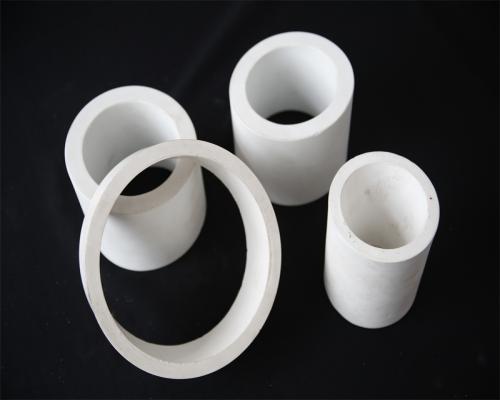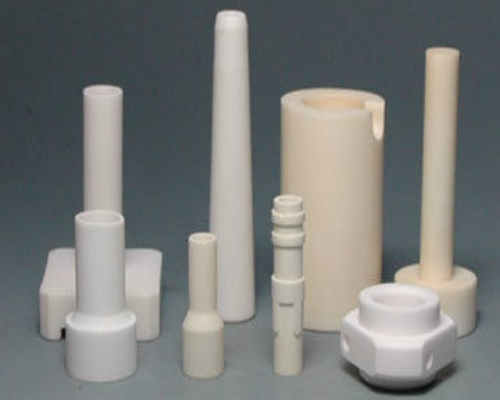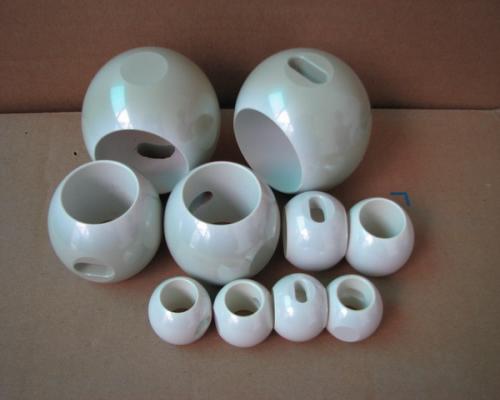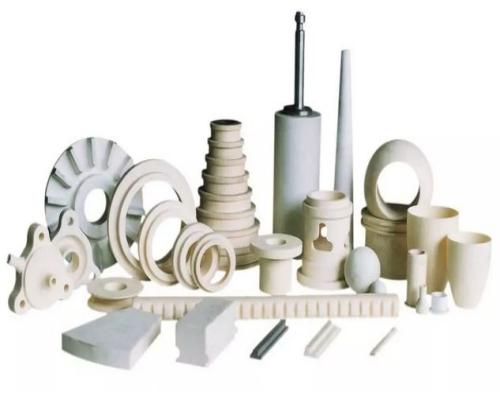Development of Advanced Ceramic Materials Industry (2)
porous ceramics
Porous ceramics are ceramic materials with a large number of interconnected or closed pores. They have the advantages of high temperature resistance, corrosion resistance, thermal shock resistance, structural design diversity, and are widely used in the fields of environmental protection, chemical engineering, energy, metallurgy, Construction, electronics and other fields.
Porous ceramics were first used on a large scale in the United States and Japan. Its preparation and application technology has developed rapidly and become increasingly mature. There are many types of porous ceramics. Now, honeycomb ceramics, foam ceramics, ceramic membranes, foam ceramics, etc. are the main applications. Among them, Honeycomb ceramics and foam ceramics occupy a very large share in the international market.
Transparent ceramic
Transparent ceramics are opaque, but optical ceramics are as transparent as glass, so it is called transparent ceramics. Due to its high strength, corrosion resistance, high temperature resistance and other properties of ceramic materials, as well as its excellent optical properties, the transparent ceramic materials industry It has developed rapidly in recent years and the scale of the industry continues to expand. According to statistics, the global value of transparent ceramics depends on the United States $10 billion.
The transparent ceramic material industry has formed a multi-level echelon competition pattern, and each country has its own advantages in industrial development. The first level is the United States, Japan and other developed countries and regions, which have absolute advantages in economic strength, core technology, and R&D capacity , market share, etc.
The second layer is represented by China, Russia and other countries. The transparent ceramic material industry is in a period of rapid development. Globally, the monopoly of the transparent ceramic material industry has intensified, and high-end technical barriers have become increasingly obvious. For example, Japan’s WordLab, Japan’s Hitachi, and General Electric Companies (General Electric) of the United States, Surmet of the United States, Dow Chemical Company of the United States, Samete Ceramics Company, Ltd. of the United States, Siemens of Germany, etc. With technological research and development, most of the transparent ceramic products with high technical content and high added value are Occupy a leading position, capital, talent and other advantages, with technology and patents as barriers.
nuclear ceramics
After nearly 80 years of development, the nuclear industry has become an industry of global concern, occupying an indispensable position in the fields of national defense and energy development. Driven by application needs, nuclear materials are constantly optimized and developed, becoming an important guarantee for the iterative progress of nuclear technology and power.
Advanced nuclear ceramic materials are widely used in the nuclear industry due to their high strength, good resistance to high temperature, radiation and chemical corrosion, and unique neutron absorption properties, and have become key basic materials for nuclear reactors, national defense and military industries. Now, The entire nuclear materials industry is in its infancy, and some research results have not yet been commercialized, which has huge market potential.
Key technologies such as high-quality nuclear-grade sub-micron powders, high-performance fibers, composite materials and corresponding molding densification are important areas for the development of the nuclear ceramic materials industry.
The application of special ceramic fibers and ceramic matrix composites in the field of nuclear energy has always attracted huge investments from technologically developed countries.
Nuclear batteries are also one of the key development directions for nuclear ceramics in the future. Isotope thermophotovoltaic systems have unique advantages in deep space exploration, but research and development are still in the laboratory prototype stage.
Research institutions and universities in the United States, Japan, Switzerland and other countries have carried out a series of research and development work on ceramic-based selective emitter materials and achieved good results, but they have not yet reached practical levels.
At this stage, hypersonic aircraft are still in the core technology breakthrough and model aircraft experimental stages. It is the main stage for competition between various technological and military powers, and has a milestone significance for the revolutionary development of future aerospace, national defense and military.
Therefore, heat-resistant materials and their preparation technology are key technologies and core materials required for reusable aircraft and hypersonic aircraft, and are of extremely important strategic significance.
Ceramic substrate
Ceramic substrates mainly include alumina substrates, aluminum nitride substrates, silicon nitride substrates and beryllium oxide substrates. They are mainly used for integrated circuits and high-power semiconductor devices. Compared with metal substrates and printed circuit boards (PCBs ), ceramic substrate has high thermal conductivity, high insulation and high temperature resistance.
The thermal conductivity is dozens of times that of metal substrates and PCBs, the compressive strength is 3 to 5 times that of metal substrates, and the use temperature can reach hundreds to thousands of degrees Celsius. Therefore, the manufactured equipment has higher integration and higher power, smaller package size and wider operating temperature range.
As electronic circuit devices and power semiconductors have increasingly higher requirements for volume and thermal conductivity, the proportion of ceramic substrates will increase. Ceramic substrates are key basic materials in many fields, and their related devices and products have been widely used in the field of power transmission , medical equipment, microwave communications, land and water transportation, aerospace. It is an indispensable key material in various related fields.
Electronic ceramics
Electronic ceramics have a wide range of applications. Ferroelectric materials with optical, electrical and optoelectronic properties are widely used in memory, detection, sensors, communications and military; semiconductor ceramic materials are key to sensor technology and sensitive components, which are closely related to Communication and computer technology are closely related.
Parts manufacturers around the world have invested heavily in the research and development of new products, new technologies, new processes, new materials and new equipment for electronic ceramics and their components, among which the United States and Japan have always been in the leading position.
Semiconductor ceramics have a very significant feature, that is, its conductivity is very sensitive to external conditions such as pressure, temperature, humidity, atmosphere, and can convert physical quantities of the external environment into electrical signals. Semiconductor ceramics include heat-sensitive ceramics, photosensitive ceramics Ceramics, gas sensitive ceramics, pressure sensitive ceramics and moisture sensitive ceramics.
Therefore, semiconductor ceramics are key materials for sensitive components and sensor technology and play a very important role in modern industrial technology, especially in the fields of computers, artificial intelligence and robot pattern recognition technology.
Research, development and even production of semiconductor ceramics involve many disciplines, such as physics, chemistry, materials science and engineering. Therefore, semiconductor ceramics are a technology-intensive and knowledge-intensive industry. Japanese products occupy an absolute dominant position in the world market, while the United States and Europe also occupies part of the market.
Japan has obvious advantages in the field of microwave dielectric ceramics. It uses its industrialization advantages to promote the standardization and high-quality of microwave dielectric ceramics. The United States focuses on nonlinear microwave dielectric ceramics and high dielectric constant microwave ceramics. Europe focuses on fixed frequency Resonator materials. South Korea is also developing rapidly in this field.
bioceramics
Bioceramics are an emerging field of materials in recent years and have received widespread attention from countries around the world. Bioceramics refer to a type of ceramic materials used for specific biological or physiological functions, and biological, medical, and biochemical applications directly used in the human body or directly related to the human body. and other ceramic materials.
They not only require high strength and toughness, but also biocompatibility, mechanical compatibility, antibacterial and other properties. Now, bioceramics companies are mainly multinational production enterprises, accounting for about 2/3 of the global bioceramics market, and the rest is mainly composed of digital Divided among hundreds of smaller competitors.
The global dental implant market is highly competitive, and there are only a few big companies in the market, namely Zimmer, Dentsply, Straumann and Nobel Biocare. The increase in the world’s aging population, lower dental transplant rates and longer Longevity is the main market driver, while increasing urban population and consumption levels are another market driver.
The largest application market for bioceramics is bioceramics for transplantation and medical devices with analytical and scientific instruments. Bioceramics for transplantation include bone materials required for surgery such as teeth, artificial joints, bones, sensors, etc.
In order to ensure that bioceramics can coexist in the human body for a long time without secondary damage, it is necessary to ensure that the mechanical properties, stability, elastic modulus, etc. are not significantly different from human bones. For example, zirconia and alumina ceramics can withstand the impact of the human body Not environmentally friendly, silicon nitride has good biocompatibility and antibacterial properties, which are the main research areas of bone materials.
Nanoceramic composite materials have important development potential in the field of bone materials. In vitro experiments have proven that osteoblasts can proliferate on a matrix composed of nanoceramic particles and coatings.
However, some studies have shown that this composite material has certain biological toxicity and may cause inflammation or immune response, leading to graft rejection. Therefore, they are not used in practice for the time being. More experimental research is needed in the future to solve this problem. .
other
Advanced ceramic materials have the advantages of high specific strength, high toughness, high chemical stability, and low density, high hardness compared with metallic materials. They show great application potential in armor materials, and have become bulletproof vests and many other military Protective materials for equipment, bulletproof vehicles, fighter jets, etc.
During World War II, the protective materials for equipment were mainly metal materials. However, with the improvement of weapon lethality and material development level, traditional materials cannot meet the requirements of modern military development. Armor materials should meet high hardness requirements, High strength, as high toughness as possible and low density, that is, “three highs and one low”.
As early as the mid-20th century, B4C materials were used in the field of bulletproof vests, and subsequently in the seats of fighter jets. In the 1970s, military powers such as Europe and the United States applied ceramic matrix composites to personnel carriers, tanks, and military aircraft. For example, the British Challenger tanks, EE-T1 Osorio main battle tank, etc. Now, a large number of armor ceramics have been used on foreign ships.
The United States uses ceramic composite armor on the antennas and turrets of ships, and it is expected that the AAAV amphibious assault ship it is studying will also use ceramic composite armor;
Armor materials in the new era are mainly developed to resist multiple strikes, improve protection and mobility, and reduce weight.
A single ceramic material has low density, good pressure resistance, good wear resistance and chemical resistance, but it is easy to break and become brittle. These shortcomings also limit its application to a certain extent. Therefore, lightweight composite armor is more Layer structure, with ceramic plate as the main body, and other composite materials.
Breaking through the structural design of traditional heavy-duty composite armor, replacing armored steel plates with high-hardness ceramic plates, giving full play to the high hardness and high compressive strength of ceramics, can improve the ballistic performance of ceramic composite armor.



